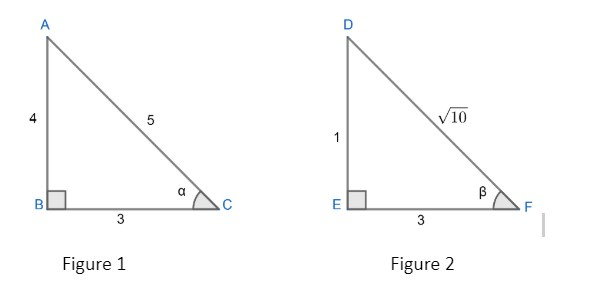Question
Question: If \(\alpha ={{\cos }^{-1}}\left( \dfrac{3}{5} \right),\beta ={{\tan }^{-1}}\left( \dfrac{1}{3} \rig...
If α=cos−1(53),β=tan−1(31) where 0<α,β<2π,then α−β is equal to:
A. sin−1(5109)
B. tan−1(149)
C. cos−1(5109)
D. tan−1(5109)
Solution
Hint: Using the basic definition of the trigonometric ratio first find the values of the sides of the triangle. Then apply Pythagoras theorem to find the other side of the triangle. Next find the values of sin, cos, tan of α,β respectively and then simplify to get the result.
Complete step-by-step answer:
In the question we are given α=cos−1(53) and β=tan−1(31)
Now, let’s consider a right angled triangle with an included angle ′α′ and another right angled triangle with an included angle ′β′ which is shown in figure 1 and figure 2 respectively.

F
We are given α=cos−1(53)
⇒cosα=53
But we know, cosθ=hypotenuseadjacent side , so in ΔABC,
cosα=ACBC=53
So, by Pythagoras theorem, we have
AB=(AC)2−(BC)2AB=52−32=4
Now we know, sinθ=hypotenuseopposite side, so we get
sinα=ACAB
Substituting the corresponding values, we get
sinα=54
Now we know, tanθ=cosθsinθ , so we can write
tanα=cosαsinα
Substituting the corresponding values, we get
tanα=5354=34
Now we got all the sine, cosine and tan of ′α′.
Now consider figure 2;
We are given,
β=tan−1(31)
⇒tanβ=31
Now we know, tanθ=adjacent sideopposite side.
In ΔDEF,, we can write
tanβ=EFDE=31
So, by Pythagoras theorem, we have
